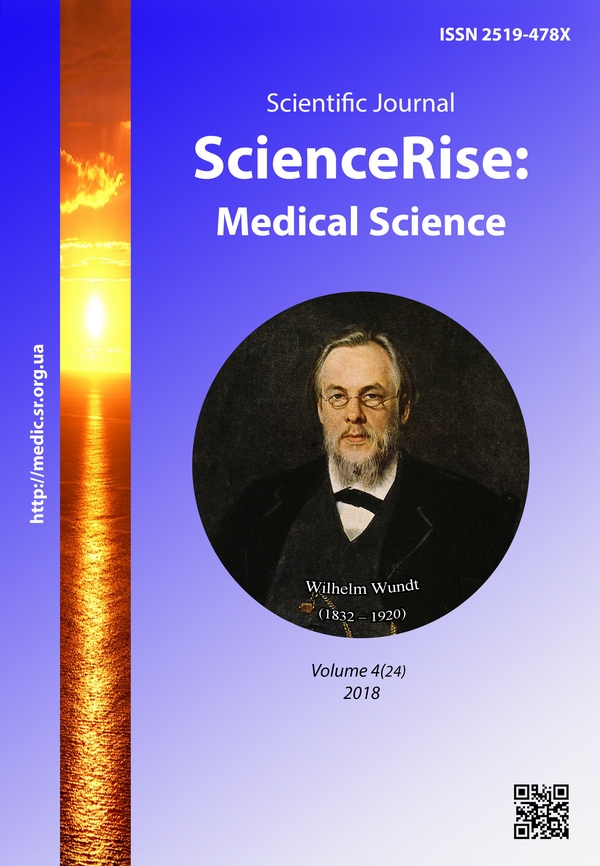Efficiency of basic treatment of asthma phenotypes in children depending on the time of disease onset
DOI:
https://doi.org/10.15587/2519-4798.2018.132665Keywords:
bronchial asthma, late-onset phenotype, children, treatment, bronchial inflammation, airway hyperresponsivenessAbstract
The study aimed at improving the effectiveness of asthma treatment by analyzing the level of control, the dynamics of inflammometric and spirometric indices in children with phenotypes of early and late onset of the disease.
Materials and methods. On the base of pulmonological department of the Regional Pediatric Hospital (Chernivtsi) 97 school-age children with late onset asthma and 59 school-age children with early onset asthma were examined. All the children received an amount of anti-inflammatory treatment equivalent to severity and control, defined by current standards of care. Determination of the effectiveness of basic therapy was carried out by assessing the control parameters of the disease using the AST test. Bronchial inflammation intensity was determined by the content of metabolites of nitrogen monoxide in the expiratory condensate by Yemchenko N.L. Bronchial lability was assessed by evaluating exersice-induced bronchoconstriction and response to short-acting β2-agonist inhalation. Airway hyperresponsiveness was assessed according to the results of bronchoprovocation testing with histamine by determining bronchial hypersensitivity to stimuli while calculating the provocation concentration (PC20H) and dose (PD20H).
Results. Achievement of asthma control after anti-inflammatory treatment was inherently slower in a group of children with late onset asthma. Clinical manifestations of asthma control were accompanied by reduce of bronchial inflammation activity in children with early-onset phenotype than in patients with a late-onset phenotype, which is reflected in the indices of asthma control. Basic control therapy did not significantly affect the expressiveness of the nonspecific bronchial hypersensitivity to direct and indirect provocative stimuli.
Conclusion. The worst indices of control achieving in schoolchildren with late- onset asthma phenotypes are associated with pronounced bronchial inflammation and hyperresponsiveness. In school-age children with a late-onset asthma phenotype basic anti-inflammatory therapy is performed reasonably according to the de-escalation principle, taking into account the control achievement
References
- Chung, K. F. (2014). Defining Phenotypes in Asthma: A Step Towards Personalized Medicine. Drugs, 74 (7), 719–728. doi: 10.1007/s40265-014-0213-9
- Brusselle, G., Germinaro, M., Weiss, S., Zangrilli, J. (2017). Reslizumab in patients with inadequately controlled late-onset asthma and elevated blood eosinophils. Pulmonary Pharmacology & Therapeutics, 43, 39–45. doi: 10.1016/j.pupt.2017.01.011
- Folliet, L., Freymond, N., Pacheco, Y. (2015). Early- and late-onsets of severe asthma are associated with divergent phenotypes of the disease. European Respiratory Journal, 46, 1050–1059. doi: 10.1183/13993003.congress-2015.pa5009
- Spycher, B. D., Silverman, M., Brooke, A. M., Minder, C. E., Kuehni, C. E. (2008). Distinguishing phenotypes of childhood wheeze and cough using latent class analysis. European Respiratory Journal, 31 (5), 974–981. doi: 10.1183/09031936.00153507
- Morgan, W. J., Stern, D. A., Sherrill, D. L., Guerra, S., Holberg, C. J., Guilbert, T. W. et. al. (2005). Outcome of Asthma and Wheezing in the First 6 Years of Life. American Journal of Respiratory and Critical Care Medicine, 172 (10), 1253–1258. doi: 10.1164/rccm.200504-525oc
- Ulrik, C. S. (2017). Late-Onset Asthma: A Diagnostic and Management Challenge. Drugs & Aging, 34 (3), 157–162. doi: 10.1007/s40266-017-0437-y
- Wu, T.-J., Chen, B.-Y., Lee, Y. L., Hsiue, T.-R., Wu, C.-F., Guo, Y. L. (2015). Different Severity and Severity Predictors in Early-Onset and Late-Onset Asthma: A Taiwanese Population-Based Study. Respiration, 90 (5), 384–392. doi: 10.1159/000439310
- Pro zatverdzhennia ta vprovadzhennia medyko-tekhnolohichnykh dokumentiv zi standartyzatsii medychnoi dopomohy pry bronkhialnii astmi (2013). Nakaz MOZ Ukrainy 08.10.2013 No. 868. Available at: http://old.moz.gov.ua/ua/portal/dn_20131008_0868.html
- FitzGerald, J. M., Bateman, E. D., Bousquet, J. (2014). Global strategy for asthma management and prevention. Available at: http://ginasthma.org/
- Childhood Asthma Control Test. The American Lung Association. Available at: https://www.asthma.com/additional-resources/asthma-control-test.html
- Emchenko, N. L., Tsyganenko, O. I., Kovalevskaya, T. V. (1994). Universal'nyi metod opredeleniya nitratov v biosredakh organizma. Klinicheskaya i laboratornaya diagnostika, 6, 19–20.
- Dryden, D. M., Spooner, C. H., Stickland, M. K., Vandermeer, B., Tjosvold, L., Bialy, L. et. al. (2010). Exercise-induced bronchoconstriction and asthma. Evid. Rep. Technol. Assess, 1 (189), 1–154. Available at: https://www.ncbi.nlm.nih.gov/pmc/articles/PMC4781551/
- Bonini, M., Palange, P. (2015). Exercise-induced bronchoconstriction: new evidence in pathogenesis, diagnosis and treatment. Asthma Research and Practice, 1, 2–4. doi: 10.1186/s40733-015-0004-4
- Juniper, E. F., Cockcroft, D. W., Hargreave, F. E. (1994). Histamine and Methacholine inhalation tests. Lund, 51.
- Turner, S. W., Palmer, L. J., Rye, P. J., Gibson, N. A., Young, S., Goldblatt J. et. al. (2005). Determinants of airway responsiveness to histamine in children. European Respiratory Journal, 25, 462–467. doi: 10.1183/09031936.05.00046404
- Moskalenko, V. F. (Ed.) (2009). Biostatystyka. Kyiv: Knyha plius, 184.
- Rennie, D., Lawson, J., Karunanayake, C., Dosman, J., Pahwa, P., Senthiselvan, A. (2017). Predictors of early and late onset asthma in a rural population of children: The Saskatchewan Rural Health Study. European Respiratory Journal, 50, 625–630. doi: 10.1183/1393003.congress-2017.pa2625
Downloads
Published
How to Cite
Issue
Section
License
Copyright (c) 2018 L. Ivanova, M. Garas, I. Tomka, A. Skulyak, T. Donska

This work is licensed under a Creative Commons Attribution 4.0 International License.
Our journal abides by the Creative Commons CC BY copyright rights and permissions for open access journals.
Authors, who are published in this journal, agree to the following conditions:
1. The authors reserve the right to authorship of the work and pass the first publication right of this work to the journal under the terms of a Creative Commons CC BY, which allows others to freely distribute the published research with the obligatory reference to the authors of the original work and the first publication of the work in this journal.
2. The authors have the right to conclude separate supplement agreements that relate to non-exclusive work distribution in the form in which it has been published by the journal (for example, to upload the work to the online storage of the journal or publish it as part of a monograph), provided that the reference to the first publication of the work in this journal is included.









